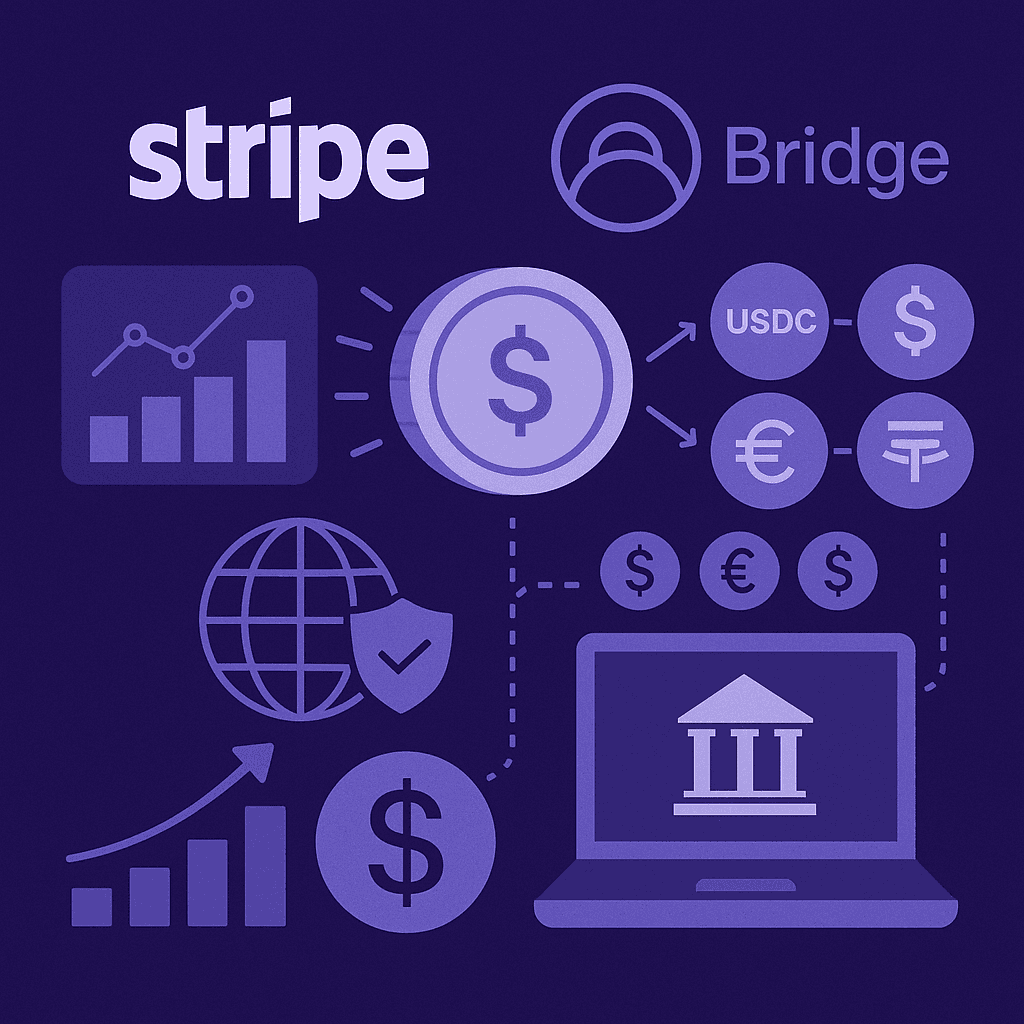How Stripe's historic $1.1 billion bet on Bridge Network reshapes the $250 billion stablecoin market and creates new opportunities for businesses adopting programmable money
TL;DR: The Infrastructure Revolution is Here
Stripe's $1.1 billion acquisition of Bridge Network completed in February 2025 isn’t just the largest fintech acquisition of the year. It's a declaration that stablecoin infrastructure is now critical business infrastructure. For businesses still processing payments through traditional rails, this deal signals it's time to evaluate crypto treasury management and stablecoin business accounts before competitors gain an insurmountable advantage.
Why Stripe Paid 10x Revenue: The Real Infrastructure Play
The $250 Billion Market Stripe Just Entered
The stablecoin market has exploded to over $250 billion in total supply, with transfer volumes hitting $27.6 trillion in 2024 surpassing the combined volume of Visa and Mastercard transactions. When you're buying the rails for a market this size, traditional revenue multiples become irrelevant.
Bridge experienced dramatic expansion, growing "more than 10 times this year" and processing "many billions in payment volume". But Stripe wasn't just buying current revenue, they were buying the foundation for programmable money infrastructure.
What Stripe Really Acquired
1. Stablecoin-Native Payment Rails Bridge specialized in helping financial institutions seamlessly integrate stablecoin technology, with built-in conversion between USDC, USDT, and traditional currencies. This wasn't just another API, it was complete DeFi business banking infrastructure.
2. Cross-Border Payment Infrastructure Stripe processes millions of cross-border transactions daily, a segment growing 50% annually. Bridge's infrastructure could "meaningfully reduce costs and streamline transactions compared to traditional financial networks".
3. Regulatory Compliance Framework Bridge had navigated the complex regulatory landscape for stablecoin payment processing, building compliance tools that traditional processors desperately needed for crypto treasury management.
The 10x Multiple Strategic Logic
Consider the market dynamics:
Stablecoin market cap crossed $200 billion for the first time in December 2024
Treasury Secretary Scott Bessent projects the dollar stablecoin market could hit $2 trillion
Stablecoins accounted for nearly half of transaction volume on major platforms in 2024
Traditional payment processors charge 2.9% + $0.30 per transaction vs. near-zero stablecoin rails
When you're buying infrastructure for a market projected to grow 10x, paying 10x revenue isn't expensive, it's strategic positioning for programmable yield opportunities.
The Race to Control Stablecoin-to-Fiat Conversion Infrastructure
Why Conversion Rails Are the New Gold Rush
The Stripe-Bridge deal triggered a race among financial giants to control the critical stablecoin-to-fiat conversion layer. As Stripe's head of money movement explained, they were "missing a key component" for cross-border transactions until Bridge provided "seamless handling" capabilities.
The Conversion Chokepoint Explained:
Sending USDC on-chain costs fractions of pennies
Converting between stablecoins and fiat remains expensive and complex
Whoever controls conversion infrastructure controls the entire stablecoin economy's on/off ramps
Who's Racing to Catch Up
Traditional Banking's Response JPMorgan's Kinexys platform and the emerging bank consortium (JPM, Bank of America, Citi) represent traditional finance's attempt to build competing rails. But they're building on legacy infrastructure while Stripe now owns stablecoin-native rails.
Payment Processor Scramble Companies like Square, Adyen, and others are now scrambling to build or acquire stablecoin business account capabilities. The Bridge acquisition marked "Stripe's largest acquisition to date and tangible push into crypto".
Fintech Integration Rush PayPal, Bank of America, and other major financial institutions have launched stablecoins or indicated market entry plans, but lack the integrated infrastructure Stripe now controls.
What This Means for Embedded Finance and DeFi Business Banking
The Embedded Finance Paradigm Shift
Traditional banks, payment providers, and fintechs are recognizing that "stablecoin adoption is not a question of if, but of how to execute". The post-Bridge world transforms embedded finance from payment processing to programmable money management.
New Capabilities Unlocked:
Instant yield generation on payment balances through high yield business bank accounts
Programmable payment conditions (escrow, time-locks, multi-sig approvals)
Global settlement without correspondent banking delays
Zero-fee payment processing through yield-based revenue models
The DeFi Business Banking Opportunity
While Stripe captured existing stablecoin rails, the next generation of infrastructure—programmable yield accounts, automated treasury management, and DeFi-native business banking—represents an even larger opportunity.
What Businesses Need Now:
USDC yield accounts for companies that automatically optimize returns
Pull-based payment systems that continue earning yield until claimed
Dynamic pricing models based on yield generation potential
Crypto cash management tools that integrate with existing workflows
Regulatory Tailwinds Accelerating Adoption
The GENIUS Act: Removing Final Barriers
The U.S. GENIUS Act, which cleared a key Senate hurdle, explicitly allows banks to issue and custody stablecoins. This regulatory clarity removes the final institutional adoption barriers.
Key Regulatory Developments:
Banks can issue stablecoins backed by cash and Treasury securities
Clear custody frameworks for institutional stablecoin treasury strategy
Streamlined compliance for USDC business accounts
European firms benefit from clearer regulatory paths through MiCA, with only 18% viewing regulation as an adoption barrier.
Strategic Implications for Businesses
The Competitive Imperative
Survey data shows 90% of financial institutions are "taking action" on stablecoins, with 86% reporting infrastructure readiness. For businesses watching this transformation, the question isn't whether to adopt crypto treasury management—it's how quickly you can move.
Immediate Evaluation Areas:
1. Payment Stack Assessment If you're processing payments through traditional rails only, you're missing:
Cost reduction opportunities (near-zero transaction fees)
Revenue generation potential (yield on payment balances)
Global reach advantages (instant cross-border settlement)
2. Treasury Management Evolution Latin America leads real-world stablecoin adoption, with 71% using stablecoins for cross-border payments, demonstrating practical earn yield on business funds applications.
3. Programmable Finance Infrastructure The future belongs to platforms offering:
Stablecoin business accounts with automatic yield optimization
DeFi treasury tools for sophisticated capital management
Embedded DeFi capabilities without cryptocurrency complexity
Regional Adoption Patterns
North America: Infrastructure is mature, with 88% of firms seeing stablecoin regulation as enablement rather than barrier
Asia-Pacific: 49% cite market expansion as the primary stablecoin driver, indicating growth-focused adoption
Europe: 42% cite legacy system risks and 37% demand safer payment rails, driving security-focused implementations
The Next Wave of Stablecoin Infrastructure Innovation
Beyond Payment Processing: Programmable Banking
While Stripe secured existing stablecoin payment rails, the next infrastructure layer focuses on programmable business banking:
Smart Account Architecture
High-yield, non-custodial DeFi accounts that automatically optimize yield
Pull-based payment systems where funds earn yield until claimed
Automated treasury functions powered by DeFi business banking
Yield-Native Business Tools
Dynamic discounting on invoices based on projected yield
Subscription models where yield covers recurring costs
Treasury segmentation for automated capital allocation
Market Projections and Growth Drivers
Asset manager Bitwise projects the stablecoin market reaching $400 billion in 2025, driven by:
Congressional stablecoin legislation providing regulatory clarity
Fintech applications integrating stablecoins following PayPal's PYUSD example
Increasing role in global payments and remittances
Circle analysts anticipate the stablecoin market growing 8x from current levels, suggesting massive infrastructure investment opportunities.
Competitive Landscape Analysis
Winners in the Post-Bridge Era
Infrastructure Providers with Programmable Features Companies building programmable yield infrastructure (like RebelFi's smart account systems) that go beyond simple payment processing
Platforms Offering Zero-Fee Models Businesses that can eliminate payment fees through yield generation rather than charging transaction fees
DeFi-Native Business Solutions Applications embedding DeFi treasury tools into everyday business workflows without requiring cryptocurrency expertise
Losers in the Transition
Traditional Payment Processors Without Stablecoin Strategies Legacy providers charging 2.9% + fees while competitors offer yield-generating alternatives
Banks Unable to Adapt to Programmable Money Financial institutions lacking stablecoin infrastructure capabilities
Fintech Apps Built on Legacy Payment Rails Platforms that can't integrate programmable stablecoin accounts and yield generation
Actionable Steps for Business Leaders
Immediate Assessment Framework
1. Current Payment Cost Analysis
Calculate total payment processing fees over past 12 months
Identify cross-border payment volumes and associated costs
Evaluate potential savings from zero-fee payment processing
2. Treasury Optimization Opportunity
Assess idle cash balances currently earning minimal yield
Calculate potential returns from high yield business bank accounts
Evaluate stablecoin treasury strategy for operational funds
3. Competitive Positioning Review
Research if competitors are adopting crypto treasury management
Assess customer demands for alternative payment methods
Evaluate DeFi business banking as competitive differentiation
Implementation Roadmap
Phase 1: Education and Pilot (30-60 days)
Research stablecoin business account providers
Pilot small-volume payments through stablecoin infrastructure
Assess regulatory compliance requirements
Phase 2: Integration and Optimization (60-90 days)
Implement USDC yield account for treasury management
Integrate stablecoin payment acceptance
Develop programmable yield strategies
Phase 3: Advanced Features (90+ days)
Deploy automated treasury management systems
Implement pull-based payment capabilities
Explore embedded DeFi opportunities
The Infrastructure Investment Thesis
Why Stablecoin Infrastructure Represents Generational Opportunity
Stripe CEO Patrick Collison stated: "We expected Bridge to grow very quickly, and we're nevertheless shocked at just how rapidly adoption is exploding. Everyone programmatically moving money will likely want a stablecoin strategy".
The Compound Effect:
Stablecoins now account for around 1% of total U.S. dollar supply, up from 0.63% at the beginning of 2024
Infrastructure investment today positions businesses for exponential adoption curves
Programmable money creates entirely new business model possibilities
The Network Effect Accelerator
The most valuable stablecoin platforms connect businesses and consumers in programmable financial relationships:
Subscriptions that pay themselves through yield generation
Loyalty programs powered by DeFi treasury tools
Seamless value exchange through stablecoin business accounts
Looking Forward: The Post-Bridge Landscape
What the $1.1B Acquisition Really Signals
Bridge co-founder Zach Abrams noted: "Stablecoins represent an entirely new payments platform. Realizing the potential of this platform will be a decades-long journey".
The Stripe-Bridge deal represents the beginning of infrastructure buildout for:
Every payment generating yield automatically
Financial logic becoming programmable through smart contracts
Global money movement happening instantly and cost-effectively
Traditional banking constraints becoming obsolete through DeFi business banking
The Next Wave of Innovation
For companies building in this space, the opportunity is clear: while Stripe bought existing stablecoin payment rails, the next generation of programmable yield infrastructure, automated treasury management, and DeFi-native business banking tools are still being built.
Key Takeaways for Business Leaders
✅ Stripe's $1.1B Bridge acquisition validates stablecoin infrastructure as critical business infrastructure
✅ The race to control stablecoin-to-fiat conversion is reshaping financial services competitive dynamics
✅ Embedded finance is evolving from payment processing to programmable money management
✅ Regulatory clarity through the GENIUS Act is accelerating institutional stablecoin adoption
✅ Businesses need stablecoin treasury strategies now to maintain competitive positioning
✅ The next innovation wave focuses on programmable yield and DeFi-native business tools
Frequently Asked Questions
Q: What makes stablecoin infrastructure different from traditional payment processing? A: Stablecoin infrastructure enables programmable money features like automatic yield generation, pull-based payments, and global instant settlement—capabilities impossible with traditional payment rails.
Q: How can businesses start adopting stablecoin treasury management? A: Begin with USDC yield accounts for idle treasury funds, pilot stablecoin payment acceptance, and evaluate DeFi business banking platforms that integrate with existing workflows.
Q: What regulatory compliance is required for stablecoin business accounts? A: Current requirements vary by jurisdiction, but the GENIUS Act is creating standardized frameworks for institutional stablecoin adoption in the U.S.
Q: What are the risks of adopting stablecoin infrastructure? A: Primary risks include regulatory changes, technology integration complexity, and yield volatility—though established stablecoin business accounts mitigate most operational risks.
Ready to explore how programmable stablecoin infrastructure could transform your business treasury management? Learn about RebelFi's innovative DeFi business banking platform and high-yield, non-custodial accounts at rebelfi.io



